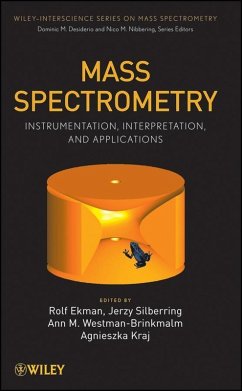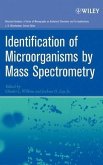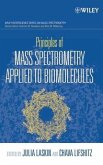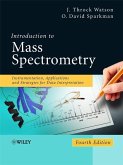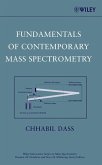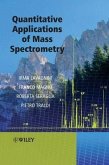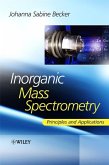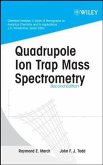Mass Spectrometry (eBook, PDF)
Instrumentation, Interpretation, and Applications
Redaktion: Ekman, Rolf; Brinkmalm, Ann M.; Silberring, Jerzy


Alle Infos zum eBook verschenken

Mass Spectrometry (eBook, PDF)
Instrumentation, Interpretation, and Applications
Redaktion: Ekman, Rolf; Brinkmalm, Ann M.; Silberring, Jerzy
- Format: PDF
- Merkliste
- Auf die Merkliste
- Bewerten Bewerten
- Teilen
- Produkt teilen
- Produkterinnerung
- Produkterinnerung

Hier können Sie sich einloggen

Bitte loggen Sie sich zunächst in Ihr Kundenkonto ein oder registrieren Sie sich bei bücher.de, um das eBook-Abo tolino select nutzen zu können.
With contributions from noted experts from Europe and North America, Mass Spectrometry Instrumentation, Interpretation, and Applications serves as a forum to introduce students to the whole world of mass spectrometry and to the many different perspectives that each scientific field brings to its use. The book emphasizes the use of this important analytical technique in many different fields, including applications for organic and inorganic chemistry, forensic science, biotechnology, and many other areas. After describing the history of mass spectrometry, the book moves on to discuss instrumentation, theory, and basic applications.…mehr
- Geräte: PC
- mit Kopierschutz
- eBook Hilfe
- Größe: 13.54MB
![Identification of Microorganisms by Mass Spectrometry (eBook, PDF) Identification of Microorganisms by Mass Spectrometry (eBook, PDF)]() Charles L. WilkinsIdentification of Microorganisms by Mass Spectrometry (eBook, PDF)136,99 €
Charles L. WilkinsIdentification of Microorganisms by Mass Spectrometry (eBook, PDF)136,99 €![Principles of Mass Spectrometry Applied to Biomolecules (eBook, PDF) Principles of Mass Spectrometry Applied to Biomolecules (eBook, PDF)]() Principles of Mass Spectrometry Applied to Biomolecules (eBook, PDF)199,99 €
Principles of Mass Spectrometry Applied to Biomolecules (eBook, PDF)199,99 €![Introduction to Mass Spectrometry (eBook, PDF) Introduction to Mass Spectrometry (eBook, PDF)]() J. Throck WatsonIntroduction to Mass Spectrometry (eBook, PDF)100,99 €
J. Throck WatsonIntroduction to Mass Spectrometry (eBook, PDF)100,99 €![Fundamentals of Contemporary Mass Spectrometry (eBook, PDF) Fundamentals of Contemporary Mass Spectrometry (eBook, PDF)]() Chhabil DassFundamentals of Contemporary Mass Spectrometry (eBook, PDF)141,99 €
Chhabil DassFundamentals of Contemporary Mass Spectrometry (eBook, PDF)141,99 €![Quantitative Applications of Mass Spectrometry (eBook, PDF) Quantitative Applications of Mass Spectrometry (eBook, PDF)]() Pietro TraldiQuantitative Applications of Mass Spectrometry (eBook, PDF)45,99 €
Pietro TraldiQuantitative Applications of Mass Spectrometry (eBook, PDF)45,99 €![Inorganic Mass Spectrometry (eBook, PDF) Inorganic Mass Spectrometry (eBook, PDF)]() Sabine BeckerInorganic Mass Spectrometry (eBook, PDF)178,99 €
Sabine BeckerInorganic Mass Spectrometry (eBook, PDF)178,99 €![Quadrupole Ion Trap Mass Spectrometry (eBook, PDF) Quadrupole Ion Trap Mass Spectrometry (eBook, PDF)]() Raymond E. MarchQuadrupole Ion Trap Mass Spectrometry (eBook, PDF)175,99 €
Raymond E. MarchQuadrupole Ion Trap Mass Spectrometry (eBook, PDF)175,99 €-
-
-
Dieser Download kann aus rechtlichen Gründen nur mit Rechnungsadresse in A, B, BG, CY, CZ, D, DK, EW, E, FIN, F, GR, HR, H, IRL, I, LT, L, LR, M, NL, PL, P, R, S, SLO, SK ausgeliefert werden.
- Produktdetails
- Verlag: John Wiley & Sons
- Seitenzahl: 400
- Erscheinungstermin: 2. Dezember 2008
- Englisch
- ISBN-13: 9780470395806
- Artikelnr.: 37291930
- Verlag: John Wiley & Sons
- Seitenzahl: 400
- Erscheinungstermin: 2. Dezember 2008
- Englisch
- ISBN-13: 9780470395806
- Artikelnr.: 37291930
- Herstellerkennzeichnung Die Herstellerinformationen sind derzeit nicht verfügbar.
Contributors xv
Part I Instrumentation 1
1 Definitions and Explanations 3
Ann Westman-Brinkmalm and Gunnar Brinkmalm
References 13
2 A Mass Spectrometer's Building Blocks 15
Ann Westman-Brinkmalm and Gunnar Brinkmalm
2.1. Ion Sources 15
2.1.1. Gas Discharge 16
2.1.2. Thermal Ionization 16
2.1.3. Spark Source 19
2.1.4. Glow Discharge 20
2.1.5. Inductively Coupled Plasma 21
2.1.6. Electron Ionization 23
2.1.7. Chemical Ionization 24
2.1.8. Atmospheric Pressure Chemical Ionization 24
2.1.9. Photoionization 25
2.1.10. Multiphoton Ionization 25
2.1.11. Atmospheric Pressure Photoionization 26
2.1.12. Field Ionization 26
2.1.13. Field Desorption 27
2.1.14. Thermospray Ionization 27
2.1.15. Electrospray Ionization 27
2.1.16. Desorption Electrospray Ionization 29
2.1.17. Direct Analysis in Real Time 30
2.1.18. Secondary Ion Mass Spectrometry 31
2.1.19. Fast Atom Bombardment 33
2.1.20. Plasma Desorption 34
2.1.21. Laser Desorption/Ionization 34
2.1.22. Matrix-Assisted Laser Desorption/Ionization 35
2.1.23. Atmospheric Pressure Matrix-Assisted Laser Desorption/Ionization 37
2.2. Mass Analyzers 38
2.2.1. Time-of-Flight 40
2.2.2. Magnetic/Electric Sector 45
2.2.3. Quadrupole Mass Filter 49
2.2.4. Quadrupole Ion Trap 51
2.2.5. Orbitrap 55
2.2.6. Fourier Transform Ion Cyclotron Resonance 58
2.2.7. Accelerator Mass Spectrometry 62
2.3. Detectors 65
2.3.1. Photoplate Detector 65
2.3.2. Faraday Detector 67
2.3.3. Electron Multipliers 67
2.3.4. Focal Plane Detector 69
2.3.5. Scintillation Detector 69
2.3.6. Cryogenic Detector 70
2.3.7. Solid-State Detector 70
2.3.8. Image Current Detection 70
References 71
3 Tandem Mass Spectrometry 89
Ann Westman-Brinkmalm and Gunnar Brinkmalm
3.1. Tandem MS Analyzer Combinations 91
3.1.1. Tandem-in-Space 91
3.1.2. Tandem-in-Time 95
3.1.3. Other Tandem MS Configurations 97
3.2. Ion Activation Methods 97
3.2.1. In-Source Decay 97
3.2.2. Post-Source Decay 98
3.2.3. Collision Induced/Activated Dissociation 98
3.2.4. Photodissociation 100
3.2.5. Blackbody Infrared Radiative Dissociation 100
3.2.6. Electron Capture Dissociation 101
3.2.7. Electron Transfer Dissociation 101
3.2.8. Surface-Induced Dissociation 101
References 102
4 Separation Methods 105
Ann Westman-Brinkmalm, Jerzy Silberring, and Gunnar Brinkmalm
4.1. Chromatography 106
4.1.1. Gas Chromatography 106
4.1.2. Liquid Chromatography 107
4.1.3. Supercritical Fluid Chromatography 109
4.2. Electric-Field Driven Separations 110
4.2.1. Ion Mobility 110
4.2.2. Electrophoresis 111
References 113
Part II Interpretation 117
5 Introduction to Mass Spectra Interpretation: Organic Chemistry 119
Albert T. Lebedev
5.1. Basic Concepts 119
5.2. Inlet Systems 121
5.2.1. Direct Inlet 121
5.2.2. Chromatography-Mass Spectrometry 121
5.3. Physical Bases of Mass Spectrometry 128
5.3.1. Electron Ionization 129
5.3.2. Basics of Fragmentation Processes in Mass Spectrometry 130
5.3.3. Metastable Ions 135
5.4. Theoretical Rules and Approaches to Interpret Mass Spectra 137
5.4.1. Stability of Charged and Neutral Particles 137
5.4.2. The Concept of Charge and Unpaired Electron Localization 148
5.4.3. Charge Remote Fragmentation 151
5.5. Practical Approaches to Interpret Mass Spectra 152
5.5.1. Molecular Ion 152
5.5.2. High Resolution Mass Spectrometry 155
5.5.3. Determination of the Elemental Composition of Ions on the Basis of
Isotopic Peaks 158
5.5.4. The Nitrogen Rule 164
5.5.5. Establishing the 13 C Isotope Content in Natural Samples 166
5.5.6. Calculation of the Isotopic Purity of Samples 166
5.5.7. Fragment Ions 168
5.5.8. Mass Spectral Libraries 173
5.5.9. Additional Mass Spectral Information 173
5.5.10. Fragmentation Scheme 175
References 177
6 Sequencing of Peptides and Proteins 179
Marek Noga, Tomasz Dylag, and Jerzy Silberring
6.1. Basic Concepts 179
6.2. Tandem Mass Spectrometry of Peptides and Proteins 181
6.3. Peptide Fragmentation Nomenclature 183
6.3.1. Roepstorff's Nomenclature 183
6.3.2. Biemann's Nomenclature 185
6.3.3. Cyclic Peptides 187
6.4. Technical Aspects and Fragmentation Rules 188
6.5. Why Peptide Sequencing? 190
6.6. De Novo Sequencing 192
6.6.1. Data Acquisition 193
6.6.2. Sequencing Procedure Examples 194
6.6.3. Tips and Tricks 205
6.7. Peptide Derivatization Prior to Fragmentation 207
6.7.1. Simplification of Fragmentation Patterns 208
6.7.2. Stable Isotopes Labeling 209
Acknowledgments 210
References 210
Online Tutorials 210
7 Optimizing Sensitivity and Specificity in Mass Spectrometric Proteome
Analysis 211
Jan Eriksson and David Fenyö
7.1. Quantitation 212
7.2. Peptide and Protein Identification 213
7.3. Success Rate and Relative Dynamic Range 218
7.4. Summary 220
References 220
Part III Applications 223
8 Doping Control 225
Graham Trout
References 233
9 Oceanography 235
R. Timothy Short, Robert H. Byrne, David Hollander, Johan Schijf, Strawn K.
Toler, and Edward S. VanVleet
References 241
10 "omics" Applications 243
Simone König
10.1. Introduction 243
10.2. Genomics and Transcriptomics 246
10.3. Proteomics 248
10.4. Metabolomics 251
11 Space Sciences 253
Robert Sheldon
11.1. Introduction 253
11.2. Origins 254
11.3. Dynamics 256
11.4. The Space MS Paradox 257
11.5. A Brief History of Space MS 259
11.5.1. Beginnings 259
11.5.2. Linear TOF-MS 260
11.5.3. Isochronous TOF-MS 262
11.6. GENESIS and the Future 264
References 264
12 Bioterrorism 267
Vito G. DelVecchio and Cesar V. Mujer
12.1. What is Bioterrorism? 267
12.2. Some Historical Accounts of Bioterrorism 267
12.3. Geneva Protocol of 1925 and Biological Weapons Convention of 1972 268
12.4. Categories of Biothreat Agents 268
12.5. Challenges 269
12.6. MS Identification of Biomarker Proteins 270
12.7. Development of New Therapeutics and Vaccines Using Immunoproteomics
271
References 272
13 Imaging of Small Molecules 275
Mägorzata Iwona Szynkowska
13.1. SIMS Imaging 277
13.2. Biological Applications (Cells, Tissues, and Pharmaceuticals) 278
13.3. Catalysis 280
13.4. Forensics 281
13.5. Semiconductors 282
13.6. The Future 283
References 285
14 Utilization of Mass Spectrometry In Clinical Chemistry 287
Donald H. Chace
14.1. Introduction 287
14.2. Where are Mass Spectrometers Utilized in Clinical Applications? 288
14.3. Most Common Analytes Detected by Mass Spectrometers 288
14.4. Multianalyte Detection of Clinical Biomarkers, The Real Success Story
289
14.5. Quantitative Profiling 291
14.6. A Clinical Example of the Use of Mass Spectrometry 292
14.7. Demonstrations of Concepts of Quantification in Clinical Chemistry
294
14.7.1. Tandem Mass Spectrometry and Sorting (Pocket Change) 294
14.7.2. Isotope Dilution and Quantification (the Jelly Bean Experiment) 295
15 Polymers 299
Maurizio S. Montaudo
15.1. Introduction 299
15.2. Instrumentation, Sample Preparation, and Matrices 300
15.3. Analysis of Ultrapure Polymer Samples 301
15.4. Analysis of Polymer Samples in which all Chains Possess the Same
Backbone 301
15.5. Analysis of Polymer Mixtures with Different Backbones 303
15.6. Determination of Average Molar Masses 303
References 306
16 Forensic Sciences 309
Maria Kala
16.1. Introduction 309
16.2. Materials Examined and Goals of Analysis 311
16.3. Sample Preparation 312
16.4. Systematic Toxicological Analysis 312
16.4.1. GC-MS Procedures 315
16.4.2. LC-MS Procedures 315
16.5. Quantitative Analysis 317
16.6. Identification of Arsons 319
References 319
17 New Approaches to Neurochemistry 321
Jonas Bergquist, Jerzy Silberring, and Rolf Ekman
17.1. Introduction 321
17.2. Why is there so Little Research in this Area? 322
17.3. Proteomics and Neurochemistry 323
17.3.1. The Synapse 324
17.3.2. Learning and Memory 324
17.3.3. The Brain and the Immune System 325
17.3.4. Stress and Anxiety 327
17.3.5. Psychiatric Diseases and Disorders 329
17.3.6. Chronic Fatigue Syndrome 329
17.3.7. Addiction 330
17.3.8. Pain 331
17.3.9. Neurodegenerative Diseases 331
17.4. Conclusions 333
Acknowledgments 333
References 334
Part IV Appendix 337
Index 353
Contributors xv
Part I Instrumentation 1
1 Definitions and Explanations 3
Ann Westman-Brinkmalm and Gunnar Brinkmalm
References 13
2 A Mass Spectrometer's Building Blocks 15
Ann Westman-Brinkmalm and Gunnar Brinkmalm
2.1. Ion Sources 15
2.1.1. Gas Discharge 16
2.1.2. Thermal Ionization 16
2.1.3. Spark Source 19
2.1.4. Glow Discharge 20
2.1.5. Inductively Coupled Plasma 21
2.1.6. Electron Ionization 23
2.1.7. Chemical Ionization 24
2.1.8. Atmospheric Pressure Chemical Ionization 24
2.1.9. Photoionization 25
2.1.10. Multiphoton Ionization 25
2.1.11. Atmospheric Pressure Photoionization 26
2.1.12. Field Ionization 26
2.1.13. Field Desorption 27
2.1.14. Thermospray Ionization 27
2.1.15. Electrospray Ionization 27
2.1.16. Desorption Electrospray Ionization 29
2.1.17. Direct Analysis in Real Time 30
2.1.18. Secondary Ion Mass Spectrometry 31
2.1.19. Fast Atom Bombardment 33
2.1.20. Plasma Desorption 34
2.1.21. Laser Desorption/Ionization 34
2.1.22. Matrix-Assisted Laser Desorption/Ionization 35
2.1.23. Atmospheric Pressure Matrix-Assisted Laser Desorption/Ionization 37
2.2. Mass Analyzers 38
2.2.1. Time-of-Flight 40
2.2.2. Magnetic/Electric Sector 45
2.2.3. Quadrupole Mass Filter 49
2.2.4. Quadrupole Ion Trap 51
2.2.5. Orbitrap 55
2.2.6. Fourier Transform Ion Cyclotron Resonance 58
2.2.7. Accelerator Mass Spectrometry 62
2.3. Detectors 65
2.3.1. Photoplate Detector 65
2.3.2. Faraday Detector 67
2.3.3. Electron Multipliers 67
2.3.4. Focal Plane Detector 69
2.3.5. Scintillation Detector 69
2.3.6. Cryogenic Detector 70
2.3.7. Solid-State Detector 70
2.3.8. Image Current Detection 70
References 71
3 Tandem Mass Spectrometry 89
Ann Westman-Brinkmalm and Gunnar Brinkmalm
3.1. Tandem MS Analyzer Combinations 91
3.1.1. Tandem-in-Space 91
3.1.2. Tandem-in-Time 95
3.1.3. Other Tandem MS Configurations 97
3.2. Ion Activation Methods 97
3.2.1. In-Source Decay 97
3.2.2. Post-Source Decay 98
3.2.3. Collision Induced/Activated Dissociation 98
3.2.4. Photodissociation 100
3.2.5. Blackbody Infrared Radiative Dissociation 100
3.2.6. Electron Capture Dissociation 101
3.2.7. Electron Transfer Dissociation 101
3.2.8. Surface-Induced Dissociation 101
References 102
4 Separation Methods 105
Ann Westman-Brinkmalm, Jerzy Silberring, and Gunnar Brinkmalm
4.1. Chromatography 106
4.1.1. Gas Chromatography 106
4.1.2. Liquid Chromatography 107
4.1.3. Supercritical Fluid Chromatography 109
4.2. Electric-Field Driven Separations 110
4.2.1. Ion Mobility 110
4.2.2. Electrophoresis 111
References 113
Part II Interpretation 117
5 Introduction to Mass Spectra Interpretation: Organic Chemistry 119
Albert T. Lebedev
5.1. Basic Concepts 119
5.2. Inlet Systems 121
5.2.1. Direct Inlet 121
5.2.2. Chromatography-Mass Spectrometry 121
5.3. Physical Bases of Mass Spectrometry 128
5.3.1. Electron Ionization 129
5.3.2. Basics of Fragmentation Processes in Mass Spectrometry 130
5.3.3. Metastable Ions 135
5.4. Theoretical Rules and Approaches to Interpret Mass Spectra 137
5.4.1. Stability of Charged and Neutral Particles 137
5.4.2. The Concept of Charge and Unpaired Electron Localization 148
5.4.3. Charge Remote Fragmentation 151
5.5. Practical Approaches to Interpret Mass Spectra 152
5.5.1. Molecular Ion 152
5.5.2. High Resolution Mass Spectrometry 155
5.5.3. Determination of the Elemental Composition of Ions on the Basis of
Isotopic Peaks 158
5.5.4. The Nitrogen Rule 164
5.5.5. Establishing the 13 C Isotope Content in Natural Samples 166
5.5.6. Calculation of the Isotopic Purity of Samples 166
5.5.7. Fragment Ions 168
5.5.8. Mass Spectral Libraries 173
5.5.9. Additional Mass Spectral Information 173
5.5.10. Fragmentation Scheme 175
References 177
6 Sequencing of Peptides and Proteins 179
Marek Noga, Tomasz Dylag, and Jerzy Silberring
6.1. Basic Concepts 179
6.2. Tandem Mass Spectrometry of Peptides and Proteins 181
6.3. Peptide Fragmentation Nomenclature 183
6.3.1. Roepstorff's Nomenclature 183
6.3.2. Biemann's Nomenclature 185
6.3.3. Cyclic Peptides 187
6.4. Technical Aspects and Fragmentation Rules 188
6.5. Why Peptide Sequencing? 190
6.6. De Novo Sequencing 192
6.6.1. Data Acquisition 193
6.6.2. Sequencing Procedure Examples 194
6.6.3. Tips and Tricks 205
6.7. Peptide Derivatization Prior to Fragmentation 207
6.7.1. Simplification of Fragmentation Patterns 208
6.7.2. Stable Isotopes Labeling 209
Acknowledgments 210
References 210
Online Tutorials 210
7 Optimizing Sensitivity and Specificity in Mass Spectrometric Proteome
Analysis 211
Jan Eriksson and David Fenyö
7.1. Quantitation 212
7.2. Peptide and Protein Identification 213
7.3. Success Rate and Relative Dynamic Range 218
7.4. Summary 220
References 220
Part III Applications 223
8 Doping Control 225
Graham Trout
References 233
9 Oceanography 235
R. Timothy Short, Robert H. Byrne, David Hollander, Johan Schijf, Strawn K.
Toler, and Edward S. VanVleet
References 241
10 "omics" Applications 243
Simone König
10.1. Introduction 243
10.2. Genomics and Transcriptomics 246
10.3. Proteomics 248
10.4. Metabolomics 251
11 Space Sciences 253
Robert Sheldon
11.1. Introduction 253
11.2. Origins 254
11.3. Dynamics 256
11.4. The Space MS Paradox 257
11.5. A Brief History of Space MS 259
11.5.1. Beginnings 259
11.5.2. Linear TOF-MS 260
11.5.3. Isochronous TOF-MS 262
11.6. GENESIS and the Future 264
References 264
12 Bioterrorism 267
Vito G. DelVecchio and Cesar V. Mujer
12.1. What is Bioterrorism? 267
12.2. Some Historical Accounts of Bioterrorism 267
12.3. Geneva Protocol of 1925 and Biological Weapons Convention of 1972 268
12.4. Categories of Biothreat Agents 268
12.5. Challenges 269
12.6. MS Identification of Biomarker Proteins 270
12.7. Development of New Therapeutics and Vaccines Using Immunoproteomics
271
References 272
13 Imaging of Small Molecules 275
Mägorzata Iwona Szynkowska
13.1. SIMS Imaging 277
13.2. Biological Applications (Cells, Tissues, and Pharmaceuticals) 278
13.3. Catalysis 280
13.4. Forensics 281
13.5. Semiconductors 282
13.6. The Future 283
References 285
14 Utilization of Mass Spectrometry In Clinical Chemistry 287
Donald H. Chace
14.1. Introduction 287
14.2. Where are Mass Spectrometers Utilized in Clinical Applications? 288
14.3. Most Common Analytes Detected by Mass Spectrometers 288
14.4. Multianalyte Detection of Clinical Biomarkers, The Real Success Story
289
14.5. Quantitative Profiling 291
14.6. A Clinical Example of the Use of Mass Spectrometry 292
14.7. Demonstrations of Concepts of Quantification in Clinical Chemistry
294
14.7.1. Tandem Mass Spectrometry and Sorting (Pocket Change) 294
14.7.2. Isotope Dilution and Quantification (the Jelly Bean Experiment) 295
15 Polymers 299
Maurizio S. Montaudo
15.1. Introduction 299
15.2. Instrumentation, Sample Preparation, and Matrices 300
15.3. Analysis of Ultrapure Polymer Samples 301
15.4. Analysis of Polymer Samples in which all Chains Possess the Same
Backbone 301
15.5. Analysis of Polymer Mixtures with Different Backbones 303
15.6. Determination of Average Molar Masses 303
References 306
16 Forensic Sciences 309
Maria Kala
16.1. Introduction 309
16.2. Materials Examined and Goals of Analysis 311
16.3. Sample Preparation 312
16.4. Systematic Toxicological Analysis 312
16.4.1. GC-MS Procedures 315
16.4.2. LC-MS Procedures 315
16.5. Quantitative Analysis 317
16.6. Identification of Arsons 319
References 319
17 New Approaches to Neurochemistry 321
Jonas Bergquist, Jerzy Silberring, and Rolf Ekman
17.1. Introduction 321
17.2. Why is there so Little Research in this Area? 322
17.3. Proteomics and Neurochemistry 323
17.3.1. The Synapse 324
17.3.2. Learning and Memory 324
17.3.3. The Brain and the Immune System 325
17.3.4. Stress and Anxiety 327
17.3.5. Psychiatric Diseases and Disorders 329
17.3.6. Chronic Fatigue Syndrome 329
17.3.7. Addiction 330
17.3.8. Pain 331
17.3.9. Neurodegenerative Diseases 331
17.4. Conclusions 333
Acknowledgments 333
References 334
Part IV Appendix 337
Index 353
